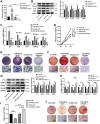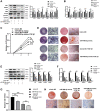M2 macrophage-derived exosomal miR-486-5p influences the differentiation potential of bone marrow mesenchymal stem cells and osteoporosis
- PMID: 37751585
- PMCID: PMC10564417
- DOI: 10.18632/aging.205031
M2 macrophage-derived exosomal miR-486-5p influences the differentiation potential of bone marrow mesenchymal stem cells and osteoporosis
Abstract
Background: An imbalance between osteogenesis and adipogenesis in bone marrow mesenchymal stem cells (BMMSCs) can cause osteoporosis. Macrophage-derived exosomes (MD-Exos) and microRNAs (miRNAs) enriched in exosomes participate in the differentiation of BMMSCs.
Methods: Bioinformatics methods were used to analyze differentially expressed miRNAs. We cocultured M2 macrophages and BMMSCs to examine the biological function of exosomal microRNA-486-5p (miR-486-5p) on BMMSCs differentiation. Gain-of-function experiments related to osteogenesis were designed to investigate the effects of exosomes carrying miR-486-5p on an ovariectomized (OVX) mice model and the direct impact of miR-486-5p on BMMSCs. A dual luciferase experiment was performed to demonstrate the target gene of miR-486-5p.
Results: Bioinformatics analysis identified high expression of miRNA-486 in M2 macrophage-derived exosomes (M2D-Exos). The in vitro results demonstrated that M2 macrophage-derived exosomal miR-486-5p enhanced osteogenic capacity but inhibited the adipogenesis of BMMSCs. The direct effect of miR-486-5p on BMMSCs showed the same effects. Animal experiments revealed that exosomal miR-486-5p rescued bone loss of OVX mice. SMAD2 was characterized as a target gene of miR-486-5p. Pathway analysis showed that M2 macrophage-derived exosomal miR-486-5p stimulated osteogenic differentiation via the TGF-β/SMAD2 signalling pathway.
Conclusions: Taken together, M2 macrophage-derived exosomal miR-486-5p influences the differentiation potential of BMMSCs through the miR-486-5p/SMAD2/TGF-β signalling pathway and osteoporosis.
Keywords: BMMSCs; differentiation; exosome; miR-486-5p; osteoporosis.
Conflict of interest statement
Figures







Similar articles
-
M2 macrophage-derived exosomes carry miR-142-3p to restore the differentiation balance of irradiated BMMSCs by targeting TGF-β1.Mol Cell Biochem. 2024 Apr;479(4):993-1010. doi: 10.1007/s11010-023-04775-3. Epub 2023 Jun 3. Mol Cell Biochem. 2024. PMID: 37269411
-
M2 macrophagy-derived exosomal miRNA-26a-5p induces osteogenic differentiation of bone mesenchymal stem cells.J Orthop Surg Res. 2022 Mar 4;17(1):137. doi: 10.1186/s13018-022-03029-0. J Orthop Surg Res. 2022. PMID: 35246197 Free PMC article.
-
BMSC-derived exosomal miR-27a-3p and miR-196b-5p regulate bone remodeling in ovariectomized rats.PeerJ. 2022 Sep 22;10:e13744. doi: 10.7717/peerj.13744. eCollection 2022. PeerJ. 2022. PMID: 36168439 Free PMC article.
-
M2 Macrophagy-derived exosomal miRNA-5106 induces bone mesenchymal stem cells towards osteoblastic fate by targeting salt-inducible kinase 2 and 3.J Nanobiotechnology. 2020 Apr 28;18(1):66. doi: 10.1186/s12951-020-00622-5. J Nanobiotechnology. 2020. Retraction in: J Nanobiotechnology. 2024 May 12;22(1):238. doi: 10.1186/s12951-024-02527-z. PMID: 32345321 Free PMC article. Retracted.
-
Exosomal microRNA-Based therapies for skin diseases.Regen Ther. 2023 Dec 23;25:101-112. doi: 10.1016/j.reth.2023.12.005. eCollection 2024 Mar. Regen Ther. 2023. PMID: 38178928 Free PMC article. Review.
Cited by
-
Exosomal non-coding RNAs: Emerging insights into therapeutic potential and mechanisms in bone healing.J Tissue Eng. 2024 Oct 5;15:20417314241286606. doi: 10.1177/20417314241286606. eCollection 2024 Jan-Dec. J Tissue Eng. 2024. PMID: 39371940 Free PMC article. Review.
-
Multifunctional Bionic Periosteum with Ion Sustained-Release for Bone Regeneration.Adv Sci (Weinh). 2024 Oct;11(39):e2403976. doi: 10.1002/advs.202403976. Epub 2024 Sep 3. Adv Sci (Weinh). 2024. PMID: 39225563 Free PMC article.
-
Knowledge Mapping of Macrophages in Osteoporosis: A Bibliometric Analysis (1999-2023).Orthop Surg. 2024 Oct;16(10):2326-2343. doi: 10.1111/os.14159. Epub 2024 Jul 9. Orthop Surg. 2024. PMID: 38982570 Free PMC article. Review.
-
Exosomes to exosome-functionalized scaffolds: a novel approach to stimulate bone regeneration.Stem Cell Res Ther. 2024 Nov 9;15(1):407. doi: 10.1186/s13287-024-04024-4. Stem Cell Res Ther. 2024. PMID: 39521993 Free PMC article. Review.
-
Skin Disorders and Osteoporosis: Unraveling the Interplay Between Vitamin D, Microbiota, and Epigenetics Within the Skin-Bone Axis.Int J Mol Sci. 2024 Dec 28;26(1):179. doi: 10.3390/ijms26010179. Int J Mol Sci. 2024. PMID: 39796035 Free PMC article. Review.
References
LinkOut - more resources
Full Text Sources

